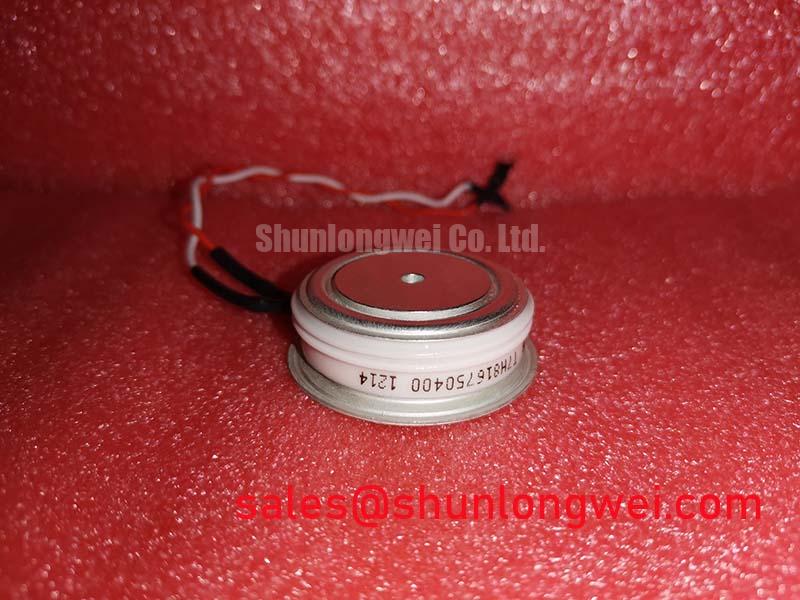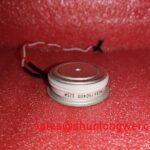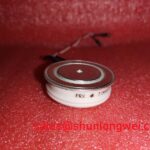T7H816750400: High-Reliability 1600V Phase Control Thyristor
Engineered for Unmatched Durability in High-Stress Industrial Power Control
Content last revised on October 9, 2025.
The T7H816750400 is a high-reliability phase control thyristor designed for superior endurance in demanding industrial applications. Its core value lies in a robust pressure-contact design that ensures exceptional performance under severe thermal cycling and fault conditions. With key specifications of 1600V | 750A (Avg) | 11,500A ITSM, this device offers both high power handling and exceptional resilience. Core engineering benefits include extended operational lifetime and simplified thermal management. For engineers designing high-power motor drives or industrial power supplies, the primary advantage of its pressure-contact construction is the elimination of solder fatigue, a common failure point in conventional modules. What defines its optimal use case? For high-power AC control systems in harsh environments demanding maximum uptime, this 750A thyristor provides a robust, field-proven solution.
Key Parameter Overview
Decoding the Specifications for Industrial Power Systems
The technical specifications of the T7H816750400 are tailored for high-power control and rectification. The parameters below are grouped by function to facilitate engineering evaluation for applications such as controlled rectifiers and AC static switches.
| Parameter | Symbol | Value |
|---|---|---|
| Voltage & Current Ratings | ||
| Repetitive Peak Off-State Voltage | VDRM/VRRM | 1600 V |
| Average On-State Current (TC=74°C) | IT(AV) | 750 A |
| RMS On-State Current (TC=74°C) | IT(RMS) | 1178 A |
| Peak One-Cycle Surge Current (60 Hz) | ITSM | 11,500 A |
| Switching & Dynamic Characteristics | ||
| Critical Rate of Rise of Off-State Voltage | dv/dt | 500 V/µs |
| Critical Rate of Rise of On-State Current | di/dt | 500 A/µs |
| Gate Trigger Current (Typical) | IGT | 80 mA |
| Thermal & Mechanical Specifications | ||
| Maximum Junction Temperature | TJ(max) | 125 °C |
| Thermal Resistance, Junction to Case | Rth(j-c) | 0.025 °C/W |
| Mounting Force | - | 8000 - 12000 lbs (35.6 - 53.4 kN) |
Download the T7H816750400 datasheet for detailed specifications and performance curves.
Application Scenarios & Value
Achieving System-Level Resilience in Industrial Motor Control
The T7H816750400 is engineered for applications where operational continuity is paramount. Its primary value is demonstrated in high-power systems susceptible to electrical and thermal stress, such as industrial Servo Drive and motor control.
A high-fidelity engineering scenario is its use in a Motor Soft Starter for a large induction motor in a mining or material processing plant. During motor startup, massive inrush currents can stress power components to their limits. The T7H816750400's exceptional surge current rating of 11,500A provides a substantial safety margin, ensuring the device survives these repeated, high-stress events without degradation. This robustness is critical for preventing costly downtime. Furthermore, its low on-state voltage (VTM) of 1.6V at 1500A minimizes conduction losses. This is not just an efficiency gain; it directly translates to less heat generation, allowing for a more compact and cost-effective thermal management solution, a key consideration in space-constrained industrial cabinets. The device's hermetically sealed ceramic package further ensures reliable operation despite the dust and vibration common in such environments.
For systems requiring a different current or voltage profile, related components can provide tailored solutions. For instance, the CM600DX-24T serves applications demanding a complete dual IGBT module configuration within a single package.
Frequently Asked Questions (FAQ)
How does the pressure-contact design of the T7H816750400 enhance system reliability over time?
The pressure-contact assembly eliminates internal solder joints, which are common points of failure in power modules due to thermal cycling. By using pressure to maintain electrical and thermal contact, the device avoids solder fatigue, resulting in a significantly longer operational lifespan and more predictable performance in applications with frequent temperature fluctuations, such as controlled rectifiers or AC static switches.
What is the practical benefit of the 11,500A ITSM rating in a real-world application?
This high surge current capability is like an integrated safety buffer. In applications like motor starters or welding power supplies, it allows the thyristor to safely withstand large, non-repetitive fault currents or high inrush currents without failing. This enhances the survivability of the entire power converter, potentially preventing catastrophic system damage and reducing the need for oversized external protection circuits.
How does the low Rth(j-c) of 0.025 °C/W impact heatsink selection and thermal design?
The low thermal resistance indicates highly efficient heat transfer from the silicon chip to the device case. For a thermal designer, this means that for a given amount of power loss, the junction temperature will remain lower. This provides two options: either use a smaller, less expensive heatsink to achieve the target operating temperature, or run the device at a higher power output while maintaining a safe junction temperature. This directly contributes to higher power density and potentially lower system cost. For a deeper understanding of thermal performance, explore our guide on Why Rth Matters: Unlocking IGBT Thermal Performance.
Is a negative gate voltage required during the off-state for this thyristor?
The datasheet specifies gate characteristics for turn-on but also highlights a dv/dt rating of 500 V/µs. While not always mandatory, applying a slight negative gate bias during the off-state is a common best practice in high-noise environments. This increases the noise margin and prevents spurious turn-on caused by high dv/dt, further hardening the system against unpredictable operational conditions found in many industrial settings.
Technical Deep Dive
A Closer Look at the Pressure-Contact Design for Long-Term Reliability
The engineering philosophy behind the T7H816750400 is centered on mechanical and thermal robustness, exemplified by its pressure-contact, or "puk," style construction. Unlike conventional power modules that rely on soldered connections to bond the silicon die to a baseplate, this design uses a precisely calibrated external force to press the internal components together. This seemingly simple change has profound implications for long-term reliability.
Think of it like the difference between a glued joint and a bolted flange. The glued joint (solder) is strong initially but can become brittle and crack after repeated cycles of expansion and contraction. The bolted flange (pressure contact), however, is designed to accommodate these movements. In a thyristor, every power cycle causes microscopic expansion and contraction. Over thousands of cycles, this fatigues solder, leading to cracks that increase thermal resistance and eventually cause failure. The T7H816750400's design completely sidesteps this failure mechanism. This makes it an inherently more reliable choice for applications like metal smelting or chemical process control, where systems run continuously for years and maintenance opportunities are scarce. The design also facilitates "double-sided cooling," where heat can be extracted from both the anode and cathode faces, a feature that allows for significantly higher power density than possible with traditional isolated baseplate modules. This commitment to robust mechanical design is a key differentiator for critical systems where failure is not an option. For further reading on power device reliability, consider resources from industry leaders like Semikron.
For engineering teams evaluating this device, the key takeaway is that its value extends beyond the electrical ratings. The T7H816750400 offers a foundational layer of mechanical resilience that translates directly into a more robust and reliable end system.









